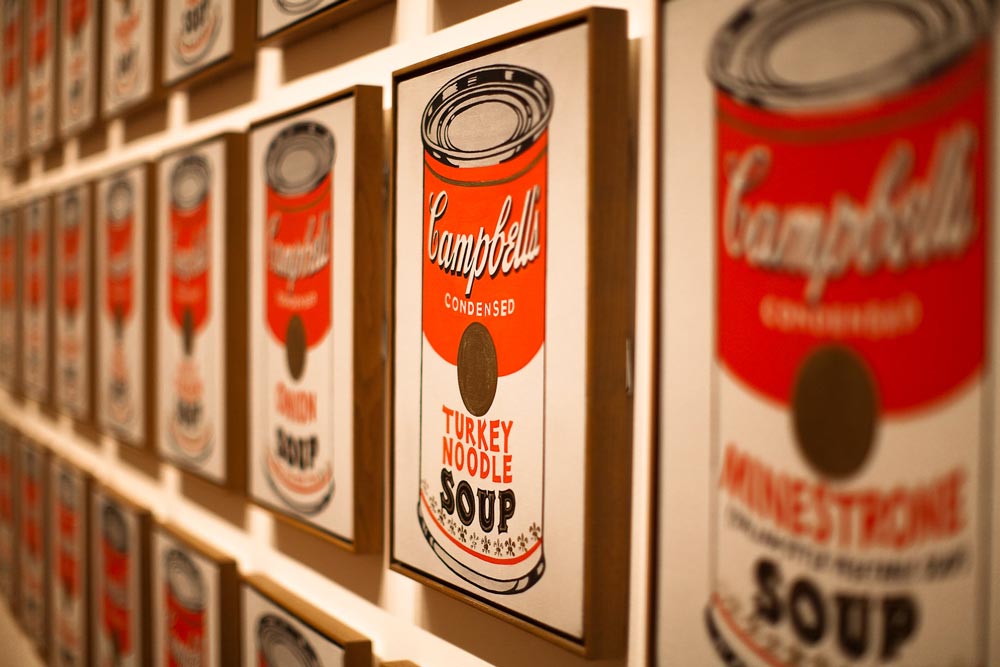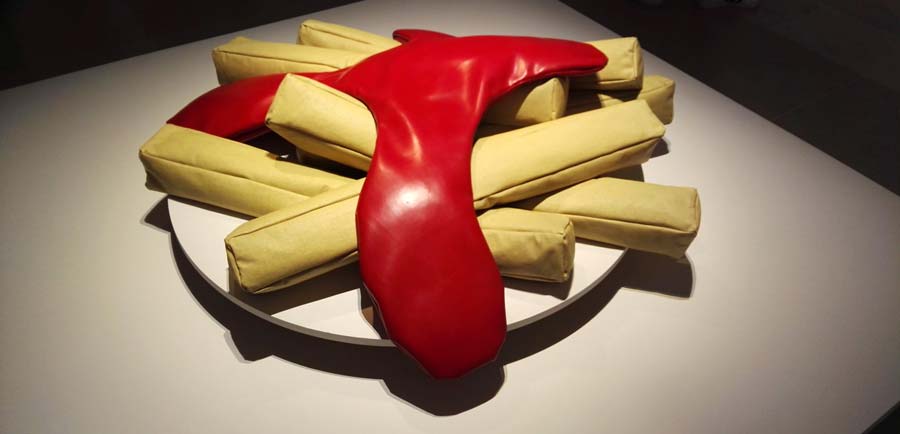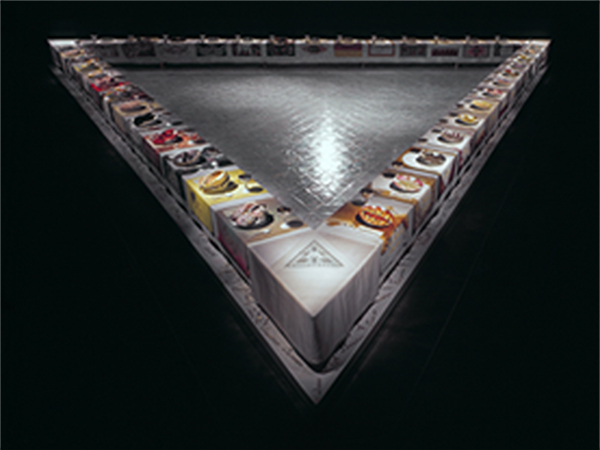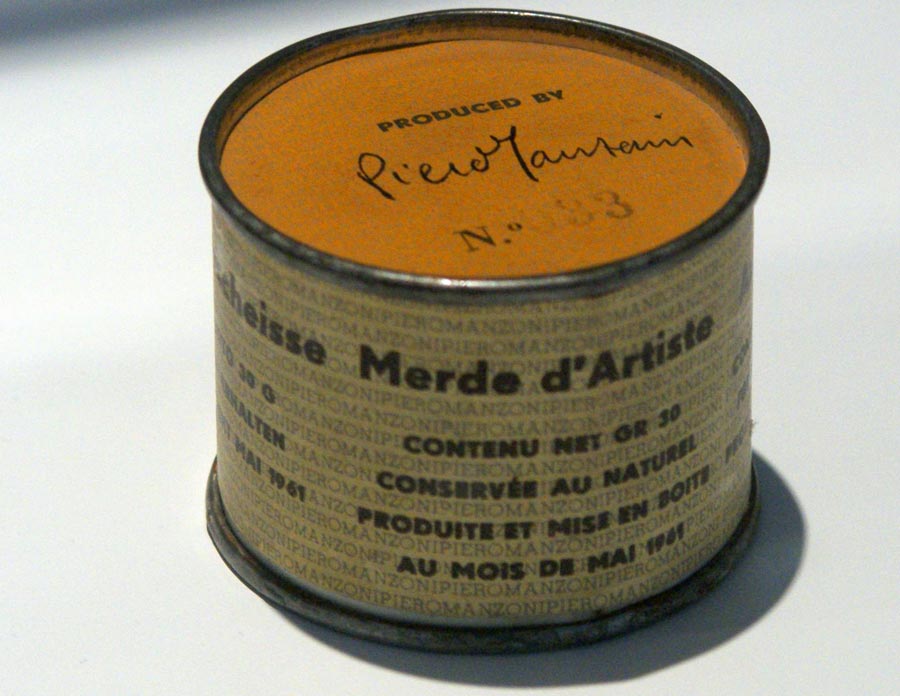
Feasting on Attitude: The Role of Food in Modern Art
Andy Warhol’s Campbell Soup Cans at the MOMA Photo by Dave Nakayama Creative Commons Attribution 2.0
Food has always been a source of inspiration for artists, both in terms of its visual appeal and its cultural significance. From still-life paintings of fruit and vegetables to avant-garde sculptures made from foodstuffs, artists have long explored the relationship between food and art. Here we will examine some of the most notable examples of food in modern art, discussing their meaning and cultural significance.
One of the most well-known examples of food in modern art is Andy Warhol’s “ Campbell’s Soup Cans ” series. Created in 1962, this series of 32 paintings features, as the title suggests, images of Campbell’s soup cans. The paintings were initially created as a commentary on the rise of consumer culture in America, with Warhol suggesting that mass-produced products like soup cans were as worthy of artistic attention as traditional subjects like landscapes or portraits. Today, the “Campbell’s Soup Cans” are seen as iconic examples of Pop Art, and their bright colors and repetitive composition continue to captivate viewers.

The Two Fridas. Frida Kahlo’s, 1939 photo by Lluís Ribes Mateu Creative Commons Attribution 2.0
Mexican artist Frida Kahlo often used food in her paintings to symbolize her struggles with physical and emotional pain. In her painting “The Two Fridas ,” she depicts two versions of herself sitting side by side, with one holding a traditional Mexican heart-shaped cake that is split open, exposing her internal organs.

French Fries and Ketchup , Claes Oldenburg, 1963,photo by Fred Romero, Creative Commons Attribution 2.
Claes Oldenburg used food to explore issues of consumerism and mass production. In the 1960s, Oldenburg began creating large-scale sculptures of everyday objects, including hamburgers, ice cream cones, and other types of food. One of his most famous sculptures is the “ Giant BLT ” (1963), which features a larger-than-life sandwich made of painted canvas and stuffed with foam rubber. The sculpture was meant to be both humorous and critical, with Oldenburg commenting on the absurdity of our obsession with food and the way that it has become commodified in modern society.

Judy Chicago’s “The Dinner Party”, Photo: Donald Woodman licensed under the Creative Commons Attribution-Share Alike 4.0 International license.
Another example of food in modern art is Judy Chicago’s “ The Dinner Party ,” a massive installation that features a triangular table with place settings for 39 historical and mythical women, each represented by a plate decorated with a unique symbol. The installation includes a number of food-related motifs, such as a vulva-shaped plate for Georgia O’Keeffe and a plate for the biblical character Judith featuring a severed head. Chicago’s work challenges traditional notions of female roles in society, and the inclusion of food as a central element emphasizes the importance of nurturing and sustenance in women’s lives.

Piero Manzoni, Artist’s Shit, 1961, Photo by Jens Cederskjold – Lcensed under the Creative Commons Attribution 3.0 Unported license.Attribution
In the 1960s, artist Piero Manzoni created a series of sculptures called “ Artist’s Shit ,” which consisted of 90 cans filled with his own excrement. The cans were labelled with the artist’s name and the words “Merda d’Artista,” and were sold for the price of their weight in gold. Manzoni’s work was a provocative commentary on the value of art, but it also spoke to the idea of consumption and waste. The inclusion of his own feces as the material of the work is a shocking and unsettling reminder of the physicality of our bodies and the inevitable cycle of life and death.

Carrie Mae Weems, Kitchen Table Series, Photo by Karl Steel Attribution-NonCommercial-ShareAlike 2.0 Generic
Food has also been used by artists to explore themes related to the human condition. In her series “ Kitchen Table ,” for example, photographer Carrie Mae Weems uses food to explore the complexities of domestic life and the way that it intersects with issues of race and gender. The series features a series of black-and-white photographs that depict a woman sitting at a kitchen table, engaging in various activities such as cooking, cleaning, and caring for children. The images are accompanied by text that suggests that the woman is grappling with a range of emotions, including frustration, anger, and loneliness. By using food as a symbol of domesticity, Weems highlights the way that food can be both a source of comfort and a reminder of the inequalities and challenges that exist within domestic life.
Another artist who uses food to explore themes related to the human condition is Vik Muniz. Muniz is known for his large-scale photographic images that are created using unconventional materials, including chocolate syrup, sugar, and other types of food. One of his most famous works is “ Pictures of Garbage ” (2008), a series of images that depict scenes of garbage dumps created using garbage itself. By using food and other materials to create these images, Muniz forces viewers to confront the darker aspects of human consumption and waste, highlighting the environmental and social impact of our modern way of life.

Janine Antoni, “Lick and Lather” (1993) photo by Hrag Vartanian Attribution-NonCommercial-ShareAlike 2.0 Generic
In recent years, food has become an increasingly popular subject in contemporary art. For example, artist Janine Antoni has created a number of works that use food as both material and subject matter. In “Gnaw,” Antoni chewed away at two 600-pound blocks of chocolate and lard, creating a series of sculptures that bear the marks of her teeth. In “Lick and Lather,” Antoni created a series of self-portraits in soap and chocolate, which she then licked and washed away, blurring the line between the materiality of art and the ephemeral nature of experience.
Of course, food has also been used in more traditional forms of art, such as still-life paintings. One contemporary artist who has created some beautiful still-life paintings featuring food is Jennifer Pochinski. Her work often features brightly coloured fruits and vegetables, arranged in a way that makes them look almost like jewels. The colours and shapes are so vibrant that they almost seem to leap off the canvas. Pochinski’s paintings are a celebration of the beauty and richness of nature, and they remind us of the importance of taking pleasure in the simple things in life.
In addition to paintings and sculptures, food has also been used in modern art installations. One example is Rirkrit Tiravanija’s “ untitled (Free ), ” which he created in 1992. The installation consisted of a small kitchen set up in a gallery space, where Tiravanija cooked and served free Thai food to visitors. The idea behind the piece was to create a sense of community and shared experience among the visitors. By providing food, Tiravanija was creating a kind of social space where people could come together and connect.
Lastly, we have the work of artist Rene Magritte, whose surrealist paintings often featured food as a central theme. In his painting, The Son of Man , a man with an apple for a face stands in front of a sea and a cloudy sky. The painting is a study of contrasts and enigma. The apple is a symbol of knowledge and the forbidden fruit, yet the man appears calm and collected. The use of the apple as a motif in the painting adds a layer of mystery and intrigue to an already surreal work.
In conclusion, food has played a significant role in modern art, and it continues to be an important subject for artists today. Whether it’s used to make a political statement, to explore the connection between our bodies and emotions, or simply to celebrate the beauty of nature,



